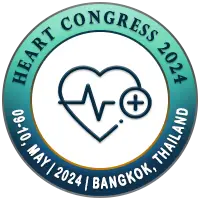
Sanna Salam
Icahn School of Medicine at Mount Sinai, USATitle: Efficacy of I-131 treatment dosage for hyperthyroidism with current institution formula
Abstract
Background: I-131 (radioactive iodine (RAI)) therapy effectively targets overactivity of the thyroid gland; however, the literature provides conflicting outcomes regarding dosage optimization of I-131 for patients with hyperthyroidism and associated clinical complications. This retrospective study aimed to validate the therapeutic efficacy of an empirically derived I-131 institution formula in resolving hyperthyroidism by establishing a euthyroid or hypothyroid state.
Methods: This retrospective chart review was undertaken for 89 adult patients (> 18 years) who received I-131 therapy from 2016 to 2020 at H&H/Queens, New York. The I-131 dose range was determined in accordance with their thyroid gland weight and thyroid uptake percentages; however, the follow-up assessment was performed for a duration of 6 - 12 months. IRB approval with reference HS-STUDY-21-01760 was obtained. All the subjects consented using a written consent document in a private room. All the patient’s data are stored confidentially in a password-protected computer, which is accessible only to the study group. The primary endpoint (i.e., treatment success) was defined by the interim development of a euthyroid state, hypothyroidism, subclinical/questionable/suspected hypothyroidism, or a questionable euthyroid state. The secondary endpoints included the frequency of repeat RAI doses and post-ablation thyroid function tests (TFTs).
Results: The univariate and multivariate analysis of patient data indicated an 83% I-131 treatment success rate defined by the achievement of a euthyroid state and hypothyroidism in 6.7% and 70.8% of patients, along with the attainment of questionable euthyroid status, questionable hypothyroidism, subclinical hypothyroidism, and suspected hypothyroidism in 1.1%, 1.1%, 2.2%, and 1.1% of patients, respectively. In addition, a low number (i.e., 9%) of patients with hyperthyroidism required repeat I-131 treatment dosages to achieve a hypothyroid or euthyroid state. The results indicated a clinically significant impact of I-131 treatment dosages on post-ablation thyroid-stimulating hormone (TSH), triiodothyronine (T3), and free thyroxin (FT4) levels.
Conclusion: The results of this study testified to the therapeutic efficacy of the current institution’s formula for I-131 treatment dosages in treating hyperthyroidism. In addition, 83% treatment success and a low retreatment requirement strengthened current evidence favoring the optimization of RAI therapy for hyperthyroidism.
Biography
Sanna Salam is PGY 3 internal medicine resident at Icahn school of mount Sinai Newyork.Area of interest is cardiology with endocrinology and work as research assistant and have publication in high index journal.

